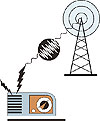When we were growing up, many of us thought that the small boxes that talked in our homes had some miniature people hidden inside them. Far from it, there was even a story told, of a certain ethnic group located in the South Western part of Uganda or the North Western part of Rwanda; as a group was busy guzzling calabashes full of the local brew, one of them got concerned as to why they were mean.


When we were growing up, many of us thought that the small boxes that talked in our homes had some miniature people hidden inside them. Far from it, there was even a story told, of a certain ethnic group located in the South Western part of Uganda or the North Western part of Rwanda; as a group was busy guzzling calabashes full of the local brew, one of them got concerned as to why they were mean.
Mean in that, they were not sharing the drink with the guys that had been "singing” tirelessly for hours; he
poured a litre or so of the booze into the radio in order to quench the thirst of the guys inside the radio.
I suppose many a folk would have done likewise. We tend to underestimate the power of these little gadgets that are found in almost all walks of our lives as we do not bother to understand how the music blaring out of them or the news casts aired via them gets to these devices and then to our hearing organs.
We are going to
briefly try to explain how these programmes move from their origins, via the airwaves into our ears. First and foremost, the term "Radio” may be defined as, "to emit energy”, it is derived from the term "radiation”.
There are many forms of radio waves, many of which exist freely in nature, e.g. the sun’s energy travelling from the sun to other planets, a hot object giving off heat to heat or warm its surrounding, etc.
In our discussion, we shall restrict ourselves to only the human made devices that transport sounds from one location to another.
In our daily usage, we have devices such as TVs, Walk Talkies, Radio Cassettes, Mobile Phones, Microwave Ovens, Remote Controls, Bluetooth devices, Wireless networks, etc. All these and many more have radio capabilities with differing intensities.
The widely revered are the "Radio Receivers” that are a major source of entertainment and news dissemination. In this category, we have the devices operating via a given Channel or band.
This band specifically defines the frequency on which that radio broadcast should be aired, each operator has an own registered band.
The bands are either provided by an international body or a local government body like the communication commission or authority.
If all radio operators were left to do as they wished, many broadcasts would interfere with each other or the broadcasters would air information that is not in the interest of the nation or society or both, hence the need for a "watch dog”.
AM and FM radios are the common type of radios bands we commonly used, in addition to these, we have LW (long wave), SW (Shortwave), these however are falling out of favour for various reasons.
All these operate on the lowest frequency of the electromagnetic spectrum.
Electromagnetic waves are much similar to sound waves when considering its wave character, but differ in that, the former are made of electric and magnetic parameters, and not mechanical attributes. One more point; radio waves have two aspects that are used in the transmission and reception of signals, i.e. "Amplitude” and "frequency”.
The radio station sends information by transforming it into the radio waves before transmitting it through air by its transmitters.
This is what is known as modulation. This is done by changing the basic characteristics, frequency or amplitude; there are two types of modulation techniques, Amplitude Modulation (AM) and Frequency Modulation (FM).
(to be continued)
Email: eddie@afrowebs.com


